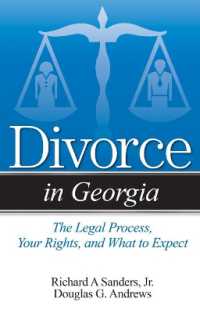Full Description
International law is archipelagic. Alongside "islands" of effective international law, you find offshore zones in which law is either undeveloped or manifestly ineffective or in which different norms, different arrangements and even unrestrained "political" factors are operating. Lawyers who work in these zones, whether on behalf of State and non-State actors, require different modes of thinking. They must be able to locate themselves in unstable decision processesby deploying appropriate legal tools and mapping schema; to identify the factors influencing decision, distinguishing the operative from the mythic ones; to project possible decisions and assess the extent they contribute to minimum and optimum order and, if they do not, to invent feasible alternative decisions. Michael Reisman describes the world international law is attached to and sets out a theory about law that enables the international lawyer to identify the common interest in its many zones and to work towards achieving a world public order of human dignity.
Contents
Excerpt of Table of Contents:
Chapter I. Breaking out of alice's looking-glass: an introduction 23
Chapter II. What is international law attached to: the facts of international life 38
Chapter III. Some propositions and conditioning factors 66
Chapter IV. The world constitutive process and its decision functions . . 90
Chapter V. The international lawmaking function 105
Chapter VI. Two modes of principled decision-making 125
Chapter VII. The international law-applying function 143
Chapter VIII. Participation arrangements for States: the transformation of self-determination 174
Chapter IX. Sovereignty and human rights: changing the internal arrange- ments of states by external means.....................198
Chapter X. The actors theory tries to ignore 212
Chapter XI. The evolution of individualism: regulating national control of persons 243
Chapter XII. The prescription and application of international human rights protections 267
Chapter XIII. Contingencies for the use of force: myth system and operational code 279
Chapter XIV. The use and abuse of military force: jus in bello 299
Chapter XV. The citizenship role of the international lawyer: fashioning goals for a public order of human dignity 312
Chapter XVI. International law as a profession: dilemmas of identity and commitment 326






